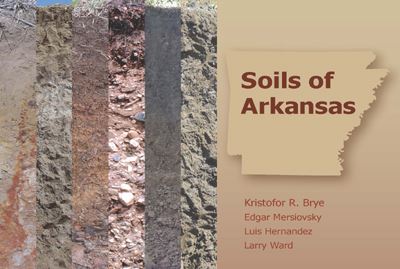Soils Of Arkansas Book Explores Characteristics Of Key Resource
FAYETTEVILLE, ARK.
The University of Arkansas System Division of Agriculture has released Soils of Arkansas, a 136-page book with maps, photos and commentary based on 50 years of soil surveys across the state. The Division published the book through a cooperative agreement with the Natural Resources Conservation Service (NRCS), an agency of the U.S. Department of Agriculture.

Soils of Arkansas, published by the University of Arkansas System Division of Agriculture and the USDA Natural Resources Conservation Service.
“This publication is meant to fill some of the knowledge gaps regarding soil by highlighting the soil and other resources of Arkansas,” said Kristofor Brye, one of the book’s four editors. Brye is professor of applied soil physics and pedology in the Division’s Department of Crop, Soil, and Environmental Sciences.
The book’s other editors are Edgar Mersiovsky, a senior regional soil scientist with the NRCS in Little Rock; Luis Hernandez, NRCS soil survey regional director for several northeastern states, and Larry B. Ward, a retired soil correlation specialist with NRCS and a registered professional soil classifier in Arkansas.
Information in the book originated with federal agencies’ efforts mapping land areas over several decades, followed by collaboration with university faculty, researchers and other agencies that analyzed the soil’s characteristics.
“There are numerous prominent industries in Arkansas that heavily rely on the soil resources in the state, namely production agriculture, timber and tourism,” Brye said. “Soils of Arkansas was conceived to provide a wide audience – from policy makers to natural resource planners to educators to students to the citizens of Arkansas and even to visiting tourists – with a basic exposure to Arkansas’ soil resources.”
Much of the book includes information about each of the state’s 11 Major Land Resource Areas, geographic areas comprised of similar geologic patterns as determined by NRCS. Photos of soil series from each of the areas depict characteristics explained in accompanying soil profile descriptions.
The book also contains information about the five factors affecting soil formation in Arkansas – parent material, topography/relief, climate, organisms and time – with several illustrative photos and maps.
Copies of the book can be obtained by contacting Brye at kbrye@uark.edu or 479-575-5742 or Mersiovsky at edgar.mersiovsky@ar.usda.gov or 501-301-3163.∆